
“There are two big supply chain constraints right now; one induced by COVID and the other induced by a shortage of labor,” contends Rick Watson, host of the Watson Weekly podcast, founder of RMW Commerce Consulting and a recent guest on The Great Supply Chain Podcast.
Rick and Tecsys’ Guy Courtin, two retail gurus, joined Bill and I on our latest episode, Clicks, Bricks and a Few Tricks: What Are Retail Supply Chain Experts Predicting for 2022?, to dissect the retail supply chain ecosystem today and explore some of the trends that are on the horizon. We discussed how retailers and brands are still working through certain chokepoints in their distribution models and how others have gotten creative in carving out opportunity from operational limitations.
There are certainly some interesting dynamics at play. Even as Black Friday / Cyber Monday 2021 proved to be relatively flat — at most a moderate increase in sales year over year — we can pan out a bit to see a different picture start to unfold; the month of November saw a healthy increase of 11.9% over last year at $109 billion. This really highlights a smoothing of the BFCM spending spikes as compared to overall growth. And indeed, this is kind of what we expected and has the retail experts asking, “Is this the dawn of the new normal?”
According to Guy, “At Costco, there are Christmas trees in August and Amazon holds Cyber Monday sales called Prime Days. With retailers extending seasonal peaks by way of promotions, the return of more ‘normal’ buying behaviors and the growth of retailers operating multiple channels, we’ve got the recipe for a unique BFCM event that speaks to a shifting retail landscape in general.” And in Tecsys’ recently posted BFCM KPIs, we can see the growing importance of multichannel retailing, with those banners having averaged much higher volumes than their single-channel counterparts.
Indeed, we are emerging from the most tumultuous period in retail supply chain since the coining of the term ‘supply chain.’ The digital commerce flight path has been accelerated and met with turbulence, which it has made for a very uncomfortable journey for ill-equipped retailers and brands. The industry is undergoing a massive reckoning that calls on retailers to meet the exceedingly high demands of a modern consumer that drifts between online and offline commerce.
So, still licking our wounds from the last two years, do we have enough visibility to see some of the macro trends on the horizon?
Together with Rick and Guy, between them armed with several decades of analyst, consultative, practitioner and vendor experience, we strive to do just that; to explore some of the more perplexing retail collaborations that are taking shape, the evolving role of the store and last mile fulfillment and how sustainability is shifting from a marketing play to an operational and financial imperative.
3 Key Takeaways
1. The Store is Transforming
Guy highlights that the transformation of in-person shopping began well before the pandemic, but that COVID was a catalyst for retailers to reconcile their store footprints and formats. We discuss the store’s continued importance in a digital commerce era, and its role in overall consumer strategy, e-commerce fulfillment, enhanced experiences, returns and circularity.
2. The Role of Supply Chain is Transforming
Converging markets are having a direct impact on stakeholders in the retail fulfillment cycle; as consumer purchasing patterns shift to convenience buying and more diverse fulfillment preferences, supply chain must adjust in kind. This is counterbalanced by the perennial labor challenges that are provoking investment in technology. As Rick puts it, “In the event that demand keeps rising and the labor supply is fixed, you’re going to have serious problems and innovation is required to bridge that gap.”
3. The Consumer is Transforming
Consumers are sending a clear message that sustainability matters and they are speaking with their wallets. Citing consumer awareness and generational shifts, our guests highlight how there is a growing expectation that brands and retailers need to take stock of their environmental impact and make strides towards sustainable sustainability. This has implications on supply chain execution in the form of order consolidation, pickup and fulfillment flexibility, environmentally conscious returns management and more.
As you navigate retail supply chain in 2022, I leave you with this thought from Guy, fresh off BFCM, but with a long-focus lens:
“Gone are the days of midnight queues at the store on Thanksgiving night. Those queues are now spread across the digital and physical world. Sure, consumers want to return to stores, but they are also leaning on multiple channels to meet their needs. What is unequivocally clear is that offering multiple channels for the consumer to interact with and then being able to fulfill those orders swiftly, is the mark of a savvy retailer today and into the future.”



